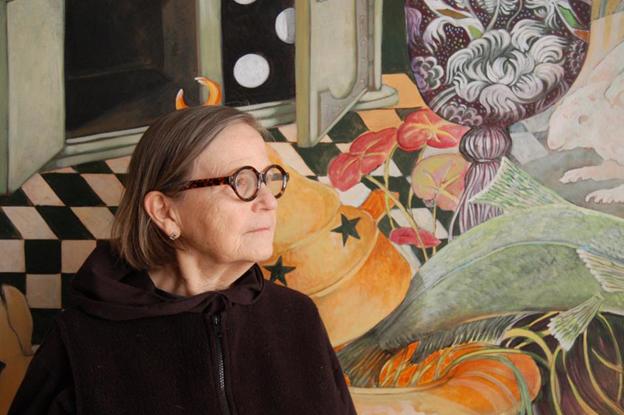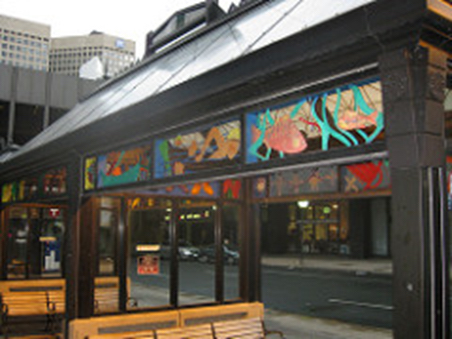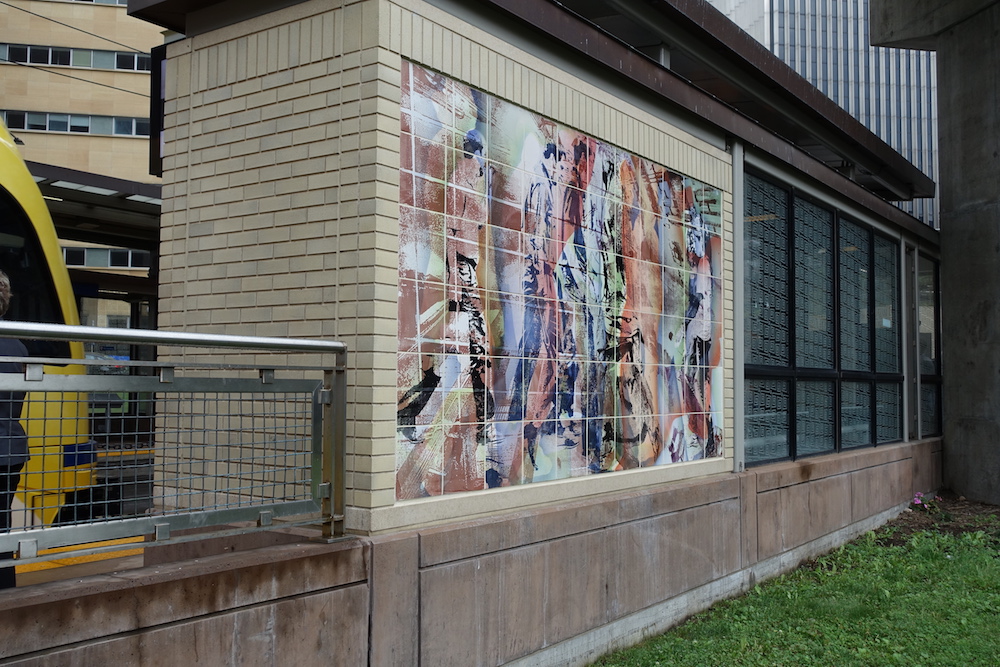The eight panels of this public art piece depict different aspects of Minnesota
INDUSTRY: the flour mills and granaries, the medical community, the brewery, mining, textiles and builders.
ARTS: Theater, dance, visual arts, architecture, music, literature, etc.
LADY SLIPPER: the state flower.
WALLEYE: The state fish.
COMMON LOON: The state bird.
FORESTRY: Tree imagery with bird and insect.
SPORTS: A myriad of sports equipment representing the many sports played in Minnesota.
INSTITUTIONS: The state capital, museums and historic places
Ellen Lanyon (1926 – 2013) was a printmaker who began her career in Chicago, and moved to New York in the 1970s where she became a member of the Heresies magazine collective.
She has been described as a “naturalist and fantasist, Audubon and Pygmalion in female form”. Her “dreamscapes” often combine animal, vegetable, and floral motifs into fantastical and semiautobiographical compositions that reflect her private mythology. Her frequent depiction of everyday objects with simultaneously domestic and sinister connotations—including scissors, sewing needles, and cutlery, objects that evoke Victorian Americana as well as Surrealist dream objects—has elicited comparisons between her work and Metaphysical Painting of the 1910s and 1920s.
Lanyon has had over seventy-five solo exhibitions, eleven museum exhibitions and three major traveling retrospectives. Her work is included in the collections of major museums throughout the United States, including the Art Institute of Chicago, the Brooklyn Museum, Museum of Contemporary Art, Chicago, the Metropolitan Museum of Art, and Museum of Modern Art, and the Walker Art Center.

Terrazzo floor at Minneapolis/St. Paul International Airport by Mykleburst and Sears
The History of Public Art at Metro Transit
The first public art piece commissioned by Metro Transit was a painted metal sculpture by Marcia McEchron. The work was designed, fabricated and installed along the top of a waiting shelter in downtown Saint Paul on Cedar Street and 4th Street in 1995. The sculpture depicted images of Minnesota trees, animals and events.

Over the next several years, Metro Transit dabbled a few more times with public art, mostly supporting the City of Minneapolis collection by providing a location for work owned by the City.
Then in 2000-2001, Metro Transit began planning the largest public art project in Minnesota, the art along the Hiawatha Line. Now known as the METRO Blue Line, the Hiawatha Line was the first light rail line in Minnesota and included public art integrated into each of the eighteen original stations. To accomplish this, Metro Transit created design teams for each station comprised of architects and artists. With preliminary designs in hand, Joan Mondale, wife of former Vice President Walter Mondale and nationally recognized arts advocate, joined the cause along with David Allen, Public Art Administrator for the Hiawatha Line. More art and more artists were added to the project, resulting in an initial collection of forty-eight artworks created by sixteen artists. Eventually, one more station was added bringing the total of public art pieces to fifty.

The Blue Line effort was an early example, in Minnesota, of large-scale placemaking. The design teams met several times with the surrounding communities to create designs that complimented and reflected the neighborhoods surrounding the stations. Artists were fully integrated into the design teams and there were few limitations, other than budget and safety, as to what the artists could develop. June 26, 2004, the Blue Line was opened from downtown Minneapolis to the Ft. Snelling Station and there was a celebration of the art at each station. December 4, 2004, the rest of the line to the Mall of America was completed and opened with much fanfare.
In 2009, with the development of Northstar Commuter Rail Line from Minneapolis to Big Lake, two more pieces were created, one at the Minneapolis terminal at Target Field and one at the Big Lake terminal. The work at the Target Field terminal was developed as part of the overall public art program for Target Field and was administered by Mary Altman, Public Arts Administrator for the City of Minneapolis. The work at Big Lake, a series of flying Canada geese, was administered by consultant Richardson, Richter & Associates.
In 2009, there were also two new transit centers developed in downtown Saint Paul and on Chicago Avenue in Minneapolis. Each of these transit centers received a public art piece. The Smith Avenue Ramp in Saint Paul became home to a multi-media piece by Dick Huss, while Chicago Lake Transit Center became home to two ceramic tile murals by Ta-coumba Aiken.
As the public art at the new transit centers were being installed, Metro Transit was already planning for public art to be integrated into the design of a second light rail line, the Green Line. Instead of developing design teams for each station, all eighteen of the Green Line stations were designed by one firm that then worked with the different artists to integrate their work. Under the direction of Alicia Vap, Metro Transit Stations and Streetscape Design Lead, seven artists were chosen, with most of the artists chosen to create art for as many as three stations. Many community meetings, coordinated by Robin Caufman, Community Engagement Manager, were held to capture the character of the neighborhoods around the stations. Because of this new design process, the works on the Green Line are more integrated into the structure of the stations and more attention was given to maintenance and sustainability.

Nearly ten years to the day after the opening of the Blue Line, the Green Line was opened and Metro Transit was home to one of the largest collections of public art in Minnesota.
In the meantime, some artwork on the Blue Line had begun to deteriorate, and Metro Transit did not have a Public Art Administrator overseeing the care of the collection. Jill Hentges, Community Outreach Coordinator, took an interest in the collection and informally filled this role for several years. In 2013, under Jill Hentges’ leadership, Metro Transit began working with conservator Kristin Cheronis to look at long term maintenance for the entire collection and in 2014 created the first annual survey of the collection. To ensure proper care of this significant asset, Metro Transit’s General Manager Brian Lamb and Engineering and Facilities Director Marilyn Porter created the position of Public Art Administrator in 2016.
Later in 2016, Metro Transit hired Mark Granlund to be Public Art Administrator. His task was to create a program that addressed maintenance of the existing collection, develop guidelines for the commissioning of new work, and develop procedures for temporary art and performances.